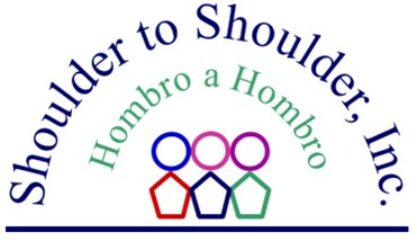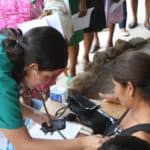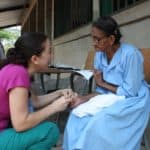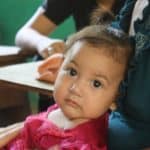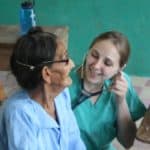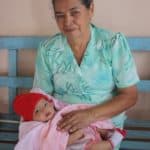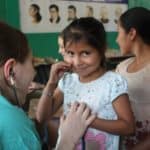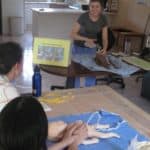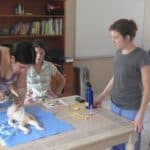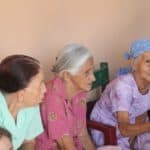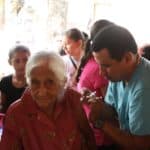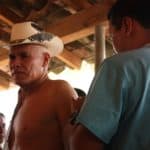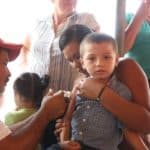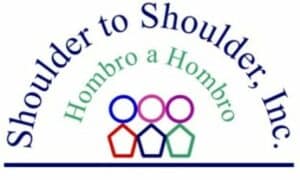Led by Dr. Ed Zuroweste, Drs. Laurel Pellegrino, Lila Worden, Brett Wanamaker, three Johns Hopkins fourth-year residents, Dr. Mish Mizrahi, a family practice attending physician from UCLA, and Mike Piorunski, an Environmental and Occupational Health Program Associate with the Migrant Clinicians Network, the Johns Hopkins brigade spent two weeks immersed in the daily healthcare needs of the Santa Lucia area.
Accompanied by our nurses and Social Service doctors, they visited some of our most remote clinics and communities. While some students attended patients in our traditional field clinics, others assisted with the vaccinations. Dr. Pellegrino, who will begin her Psychiatry residency in July, had the opportunity to see patients in her field at the Santa Lucia clinic. Brigade members conducted home visits and gave charlas, or health education talks, to hypertensive, diabetic, and pregnant patients. Both the students’ and the audience’s favorite tool, by far, was a sugar-filled zip-lock bag demonstrating the actual amount of sugar in one bottle of Coke.
In their off-time, the brigade forded the Rio Torola, toured the La Esperanza hospital, and played a lot of Catchphrase. This group was open to experiencing everything from grunt work to taking night call and really went above and beyond in filling out our government paperwork. Thank you to Johns Hopkins and Dr. Zuroweste for your continued support, and for the brigade members’ tireless efforts on the ground in Intibucá.
For more photos from the brigade, check our Facebook page.
Research Project Provides Essential Neonatal Resuscitation Education for Resource-Limited Environments
For the last year, Kathryn Taylor (Ohio State B.S. ’12; Harvard M.D. ’17) has been training Shoulder to Shoulder’s physicians, nurses, and local midwives how to save babies’ lives. Based at our Santa Lucia clinic, Kathryn has trained and evaluated our staff for basic neonatal resuscitation techniques as part of a study of Helping Babies Breathe, a joint program of the WHO, Save the Children, and the American Academy of Pediatrics. She teaches a curriculum designed for developing countries in limited resource environments.
Approximately 23% of neonatal deaths worldwide are due to asphyxiation. Helping Babies Breathe was developed on the premise that all babies deserve simple neonatal care, regardless of resources. It focuses on improving outcomes in the neonatal period and reducing birth asphyxia. Each year, an estimated 10 million babies require breathing assistance. However, only one to two percent of babies require advanced care. In hospital-based settings in the rural departments of Honduras, including Intibucá, the neonatal death rate is 46.9 deaths per 1000 live births. In the United States, there are four deaths per 1000 live births.
The course is taught at a fifth grade reading level, and focuses more on facilitation than traditional education – utilizing interaction and practice in pairs. Training partners learn to have a plan and materials in place at the time of delivery, to recognize whether a baby is breathing, and operating under time and pressure constraints in order to have a baby breathing in under a minute.
Kathryn has attended and filmed 78 births at the Santa Lucia clinic. She meets with the labor and delivery team following each birth and leads a debriefing. They review the video and find ways to improve. Kathryn will be spending her final month implementing the program at the main regional hospital in La Esperanza prior to beginning medical school in the fall. Srirama Josyula (Ohio State B.S. ’13; Ohio State M.D. ’18) will continue with the program in Santa Lucia and La Esperanza.
National Vaccination Campaign
Between April 22 and May 3, we vaccinated every scheduled child, elderly adult, and high risk individual for measles, rubella, diphtheria, pertussis (whooping cough), polio, pneumonia, rotavirus, hepatitis B, and Vitamin A.
We are still compiling the final numbers for Concepción (pop: 10,758) and San Marcos de la Sierra (pop: 9,085). Here are our stats for the municipalities of Santa Lucia (pop: 5,527), San Antonio (pop: 5,606), and Magdalena (pop: 4,815):
• Vitamin A supplements – children four and under: 420
• Tetanus – 11 year olds: 327; other groups: 80
• Diphtheria, pertussis, tetanus, hepatitis B, influenza – under 12 months: 41
• Diphtheria, pertussis, tetanus boosters – 18 months: 11; four year olds: 33
• Measles, mumps, rubella – 12-23 month olds: 16
• Rotavirus – 28
• Pneumococcal – under 12 months: 41
• Polio – under 12 months: 52
• Tuberculosis – under 12 months: 18
Pneumococcal vaccines were also provided for high-risk patients, including elderly, asthmatic, diabetic, hypertensives and patients with chronic pneumonia.
• High-risk aged 2-59: 625 scheduled, 637 reached (102%)
• Elderly aged 60 and over: 260 scheduled, 298 reached (115%)
Overall, it was a very successful campaign, part of the national vaccination campaign. These vaccinations help prevent the spread of disease and ensure the continued health of our community members.
For more photos from the vaccination campaign, check our Facebook page.

